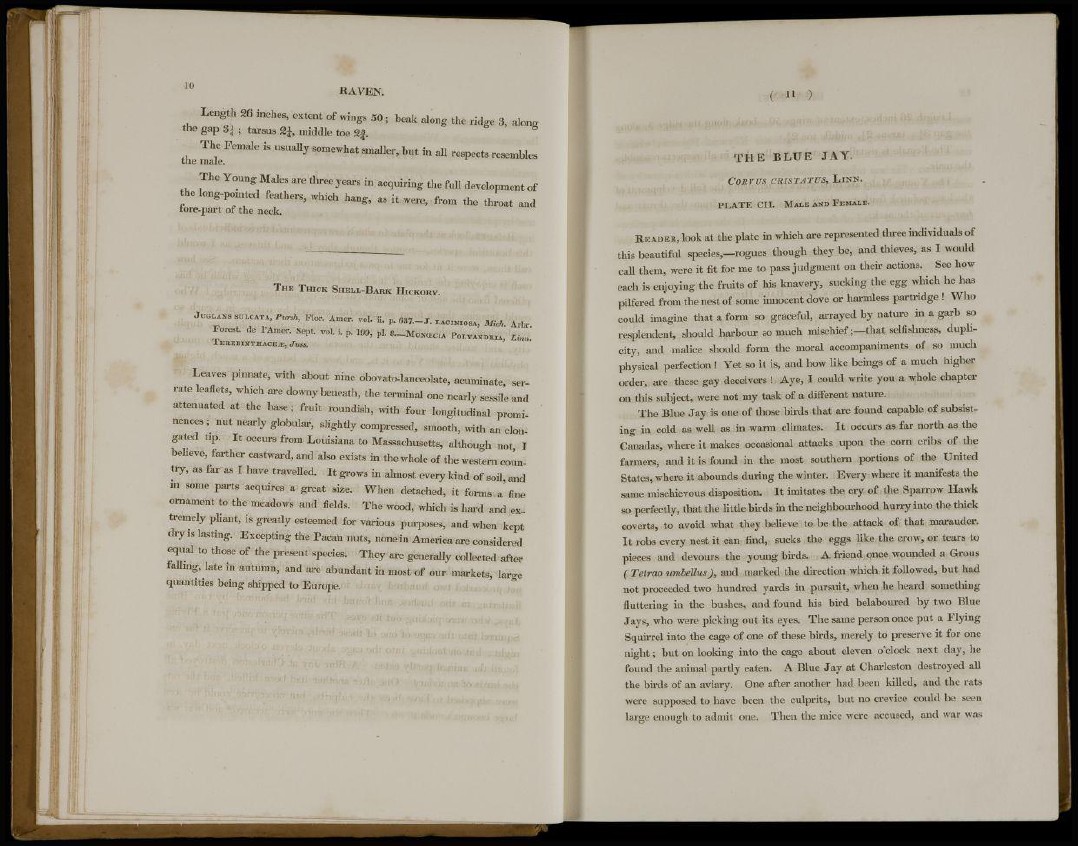
RAVEN.
Length 26 inches, extent of wings 50 ; beak along the ridge 3 , along
the gap 3 1 ; tarsus 2 J, middle toe 2 | .
The Female is usually somewhat smaller, but in all respects resembles
the male.
The Young Males are three years in acquiring the full development of
the long-pointed feathers, which hang, as it were, from the throat and
fore-part of the neck.
THE THICK SHELL-BARK HICKORY.
JUGLANS SULCATA, Ptcrsh, Flor. Amer. vol. ii. p. 637.—J. LACINIOSA, Mich. Arbr.
Forest, de l'Amer. Sept. vol. i. p. 1 9 9 , pi. 8—MONOZCIA POLYANDRIA, Linn.
TEREBINTHACEJE, JIMS.
Leaves pinnate, with about nine obovato-lanceolate, acuminate, serrate
leaflets, which are downy beneath, the terminal one nearly sessile and
attenuated at the base; fruit roundish, with four longitudinal prominences
; nut nearly globular, slightly compressed, smooth, with an elongated
tip. It occurs from Louisiana to Massachusetts, although not, I
believe, farther eastward, and also exists in the whole of the western country,
as far as I have travelled. It grows in almost every kind of soil, and
in some parts acquires a great size. When detached, it forms a fine
ornament to the meadows and fields. The wood, which is hard and extremely
pliant, is greatly esteemed for various purposes, and when kept
dry is lasting. Excepting the Paean nuts, none in America are considered
equal to those of the present species. They are generally collected after
falling, late in autumn, and are abundant in most of our markets, large
quantities being shipped to Europe.
( 1 1 )
T H E B L U E JAY.
CORVUS CRISTJTUS, LlNN.
P L A T E C I I . MALE AND FEMALE.
READER, look at the plate in which are represented three individuals of
this beautiful species,—rogues though they be, and thieves, as I would
call them, were it fit for me to pass judgment on their actions. See how
each is enjoying the fruits of his knavery, sucking the egg which he has
pilfered from the nest of some innocent dove or harmless partridge ! Who
could imagine that a form so graceful, arrayed by nature in a garb so
resplendent, should harbour so much mischief;—that selfishness, duplicity,
and malice should form the moral accompaniments of so much
physical perfection ! Yet so it is, and how like beings of a much higher
order, are these gay deceivers ! Aye, I could write you a whole chapter
on this subject, were not my task of a different nature.
The Blue J a y is one of those birds that are found capable of subsisting
in cold as well as in warm climates. It occurs as far north as the
Canadas, where it makes occasional attacks upon the corn cribs of the
farmers, and it is found in the most southern portions of the United
States, where it abounds during the winter. Every where it manifests the
same mischievous disposition. It imitates the cry of the Sparrow Hawk
so perfectly, that the little birds in the neighbourhood hurry into the thick
coverts, to avoid what they believe to be the attack of that marauder.
I t robs every nest it can find, sucks the eggs like the crow, or tears to
pieces and devours the young birds. A friend once wounded a Grous
(Tetrao umbellusJ, and marked the direction which it followed, but had
not proceeded two hundred yards in pursuit, when he heard something
fluttering in the bushes, and found his bird belaboured by two Blue
Jays, who were picking out its eyes. The same person once put a Flying
Squirrel into the cage of one of these birds, merely to preserve it for one
night; but on looking into the cage about eleven o'clock next day, he
found the animal partly eaten. A Blue J a y at Charleston destroyed all
the birds of an aviary. One after another had been killed, and the rats
were supposed to have been the culprits, but no crevice could be seen
large enough to admit one. Then the mice were accused, and war was